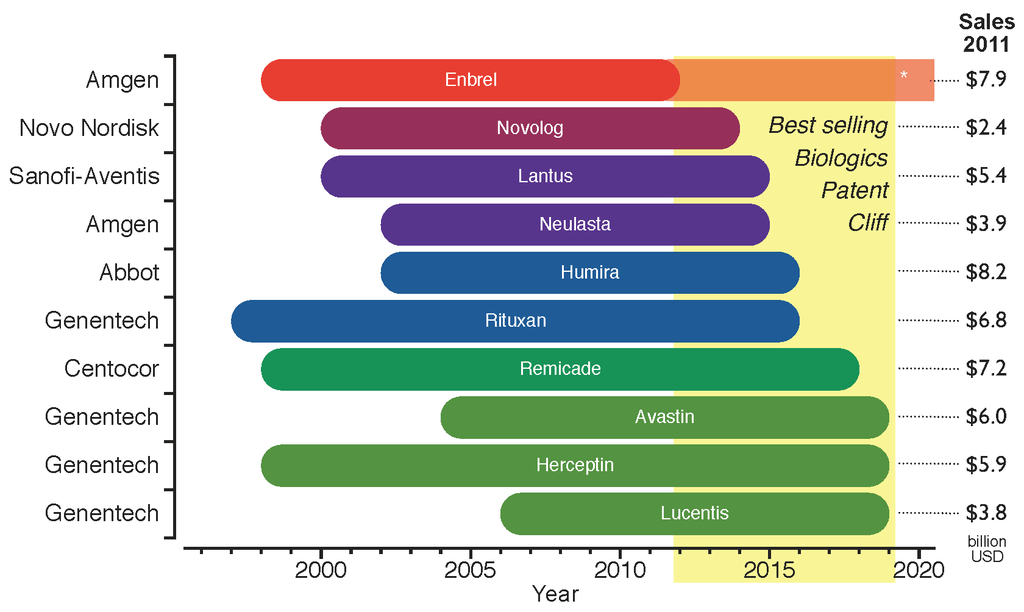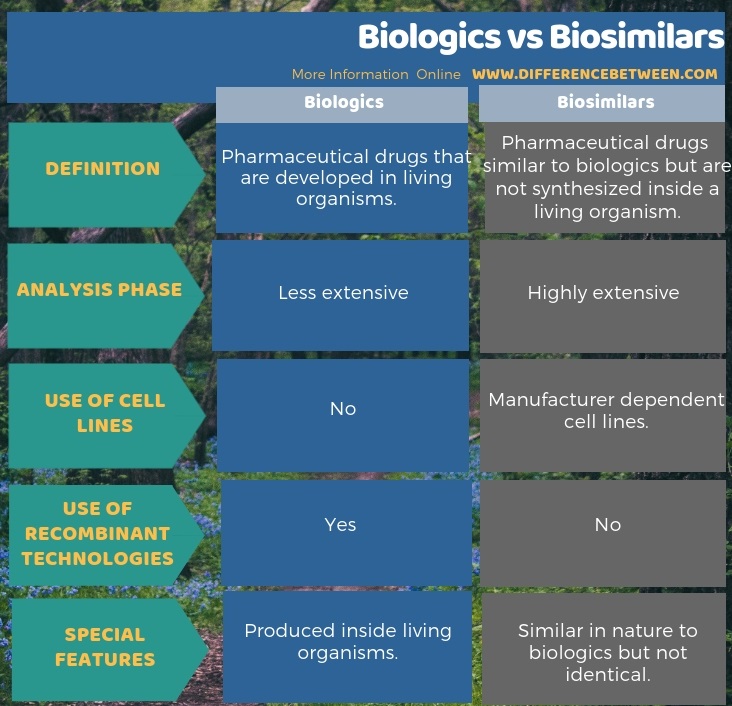Biologics and biosimilars are two types of drugs. The key difference between biologics and biosimilars is that the biologics manufacturing should be done within living organisms while biosimilars manufacturing does not involve living organisms.
With the advancement of biotechnology, the manufacture of drugs has taken a new dimension. Drug manufacturing in the commercial world uses many different modes. Biologics are pharmaceutical drugs developed in living organisms. These organisms may be prokaryotes such as bacteria or eukaryotes such as fungi and mammals. The development of biologics takes place using high-end biotechnological techniques. On the other hand, biosimilars are pharmaceutical drugs similar to biologics but are not synthesized inside a living organism. Therefore, these drugs are not identical, but similar in nature. However, there is an ongoing debate on using Biologics and Biosimilars in the market and its advantages, disadvantages, and its side effects.
CONTENTS
1. Overview and Key Difference
2. What are Biologics
3. What are Biosimilars
4. Similarities Between Biologics and Biosimilars
5. Side by Side Comparison – Biologics vs Biosimilars in Tabular Form
6. Summary
What are Biologics?
Biologics are pharmaceutical drugs that are synthesized from living organisms. These include antibodies, modulators of metabolic activity and various proteins, etc. However, these drugs are very fragile in nature. Because, biologics are highly dependent on physical factors such as temperature and pH. Furthermore, the environment of storage should mimic the original conditions. Therefore, the production of biologics is comparatively a tedious process. In addition, biologics production is facilitated by the recombinant DNA technology. Therefore, specially trained personnel should be involved in the process.

Figure 01: Biologics
Besides, the biologics can be prepared by any pharmaceutical company, and there are fewer restrictions. There are minimum risks associated with the usage of biologics as it is already produced by a living organism. Also, biologic medicines can be administered directly to the patient, and they have shown positive impacts in treatment procedures. Biologics that used in conditions such as Hepatitis, Diabetes and Rheumatoid arthritis have shown to be promising as treatment agents.
What are Biosimilars?
Biosimilars are pharmaceuticals that do not synthesize inside the living organisms. The production of biosimilars needs specific cell lines which are specific to the manufacturer. Therefore, biosimilars mimic the biologic medicines but are not identical in nature. There are possibilities of having minute differences between biologics and biosimilars pharmaceuticals of the same time. Therefore, they refer as copies of the original drug.
Besides, the manufacture of biosimilars is highly dependent on the manufacturer. After a thorough survey about the drug, its properties, its pharmacokinetic properties and its behaviour, the scientific research teams of leading pharmaceutical companies design in vitro methods of manufacturing drugs. Then, the manufactures of the drugs carry out the drug production commercially in available cell lines without revealing the identity of these cell lines.

Figure 02: Biosimilars
Production of biosimilars is more feasible as the physical conditions can be altered. But, due to this reason, the failure rate of biosimilars coming into the market is high. It is because, there are a lot of complications associated with biosimilars in comparison to the biologics. Theerefore, the usage of biosimilars is discouraged among some communities.
What are the Similarities Between Biologics and Biosimilars?
- Biologics and Biosimilars are pharmaceutical drugs.
- Both types of drugs require severe analysis before getting into the clinical trial phase.
- Also, both require extensive clinical trials based on human and animal subjects.
- Furthermore, both are used in the treatment of communicable and non – communicable diseases.
- They have similar primary structures and functions.
- Moreover, both resemble in their basic pharmacokinetic properties.
What is the Difference Between Biologics and Biosimilars?
Biologics and biosimilars are two types of drugs. The key difference between biologics and biosimilars is the involvement of living organisms during the production. Biologics production involves living organisms while biosimilars production does not. Furthermore, another difference between biologics and biosimilars is that the recombinant DNA technology is the main mode of biologics production while it is not useful in biosimilars production.
The below infographic presents more details on the difference between biologics and biosimilars.

Summary – Biologics vs Biosimilars
The controversy of usage of biologics and biosimilars has brought about new insights among the medical community. Biologics are pharmaceutical drugs which synthesize inside the living organisms. Recombinant DNA technology is widely used in biologics manufacture. In contrast, biosimilars mimic the biologics, but they are not identical in nature. Biosimilars production does not involve living organisms. Instead, they are produced in manufacturer dependent cell lines. Hence, this is the difference between biologics and biosimilars.
Reference:
1.Chan, Juliana CN, and Anthony TC Chan. “Biologics and Biosimilars: What, Why and How?” Current Neurology and Neuroscience Reports., U.S. National Library of Medicine, 2017. Available here
Image Courtesy:
1.”754962309″ by Michael Mortensen (CC BY-SA 2.0) via Flickr
2.”Biosimilars Patent Cliff” By Bruno Calo-Fernandez, Juan Martinez-Hurtado (CC BY-SA 3.0) via Commons Wikimedia
ncG1vNJzZmivp6x7pbXFn5yrnZ6YsqOx07CcnqZemLyue8OinZ%2Bdopq7pLGMm5ytr5Wau26uyKijqJ%2BZmMBurc2dZJuhn6i2rrXLmqmsZw%3D%3D